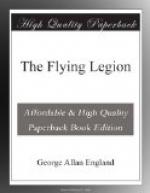Bohannan, meantime, was trying to get some general impression of the giant plane. Not all the Master’s descriptions of it, to him, had quite prepared him for the reality. Though he well knew all the largest, biggest machines in the world, this stupendous creation staggered him. By comparison with the Handley-Page, the Caproni, the D.H.-4, the Gotha 90-120, the Sikorsky, it spread itself as an eagle spreads beside a pigeon.
It lay in a kind of metallic cradle, almost like a ship ready for launching on its ways. Ahead of it, metal plates stretched away like rails, running toward the lip of the Palisades. Its quadruple floats, each the size of a tugboat and each capable of being exhausted of air, constituted a potential lifting-force of enclosed vacuums that very largely offset the weight of the mechanism. It was still a heavier-than-air machine, but the balance could be made nearly perfect. And the six helicopters, whose cylindrical, turbine-like drums gleamed with metallic glitters—three on each side along the fuselage—could at will produce an absolutely static condition of lift or even make the plane hover and soar quite vertically.
There the monster lay, outstretching its enormous sextuple wings, each wing with an area of 376 by 82.5 feet. The non-inflammable celluloid surfaces shone white as fresh-cut ivory, clean, smooth, unbreakable. The plane reminded one of some Brobdingnagian dragon-fly, resting for flight, shimmering with power as it poised for one swift leap aloft into the night.
Bohannan, still a bit confused, noted the absence of any exhaust from the speeding engines. This, too, gave a sense of vast, self-contained power. He saw stupendous propeller-blades, their varnished surfaces flicking out high-lights as the incandescents struck them. Motionless these propellers were; but something in their tense, clean sweep told of the raging cyclone to which they could whip the air, once the spinning engines should be clutched in on their shafts.
The captain’s eyes wandered over the whole enormous construction, towering there above him. He saw rows of lighted windows, each cased in shining metal; a V-pointed pilot-house—the same where the still figure had dropped over the sill of the open window—a high-raised rudder of artful curve, vast as the broadside of a barn; railed galleries running along the underbody of the fuselage, between the floats and far aft of them.
Everything gleamed and flickered with bright metal, varnish, snowy celluloid. The body of the machine looked capable of housing twice as many men as the Legion numbered. But everything, after all, was quite shrunk by the overpowering sweep of the wings. These dwarfed the fast-gathering group that stood peering up at them, like pygmies under the pinions of the fabled roc in Sinbad the Sailor’s story.
These stupendous wings, the captain now saw, were not braced together by hampering struts and wires, but seemed cantilevered into position, giving a clean run to the structure, great simplicity, and the acme of mechanical beauty. This giant bird of heaven lay in its nest, free of pattern, powerful beyond any air-mechanism ever built by man, almost a living thing, on whose back its captors might ride aloft defying man and nature, to whatsoever goal they chose.




